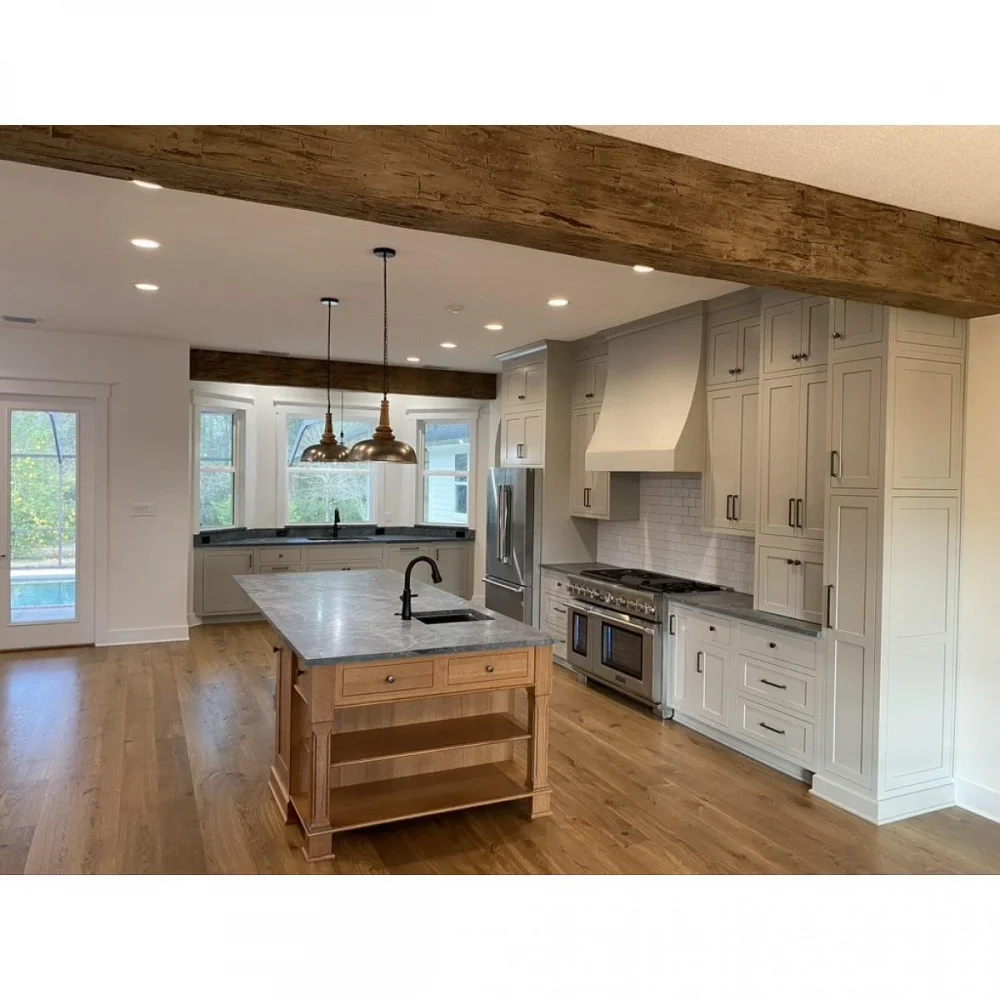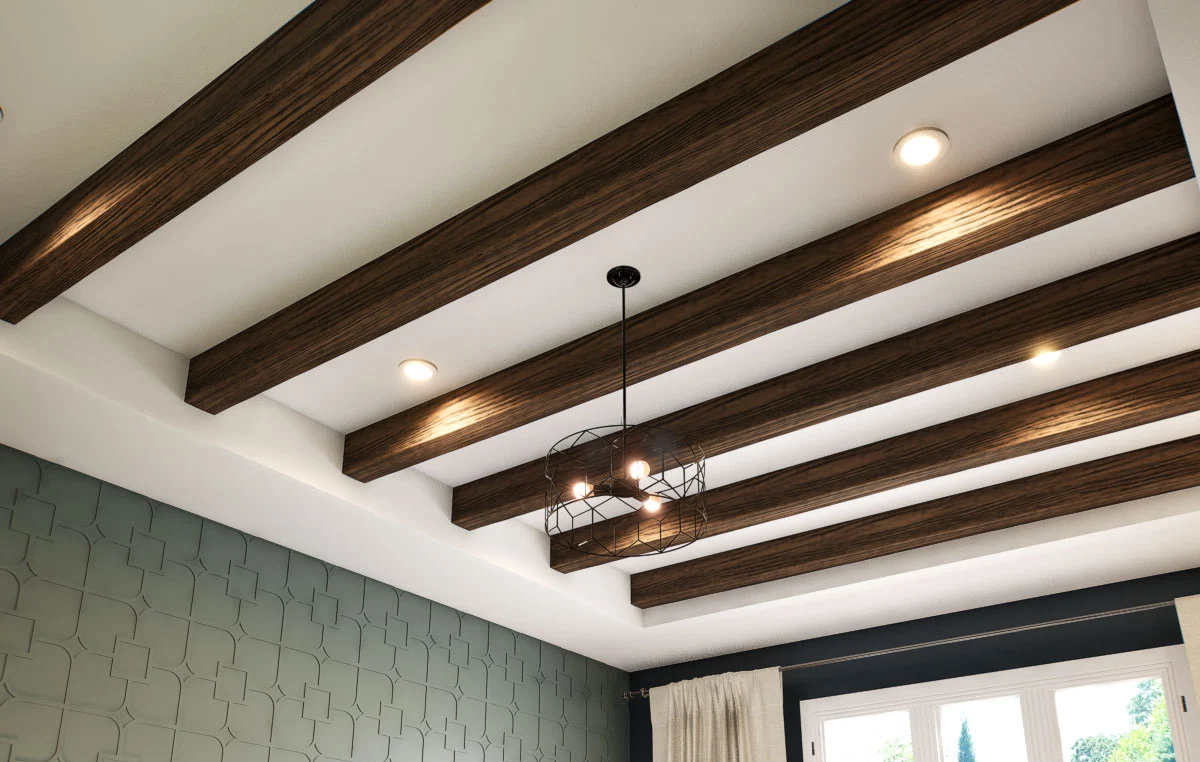Faux wood beams have revolutionized interior design, offering a cost-effective way to add warmth and character to any space. These lightweight alternatives to real wood beams provide the rustic charm of natural timber without the hefty price tag or installation challenges. Homeowners and designers alike are turning to faux beams for ceiling transformations, creating stunning visual interest that complements various architectural styles.
The versatility of faux wood beams has sparked a wave of creativity in home décor. From traditional farmhouse esthetics to modern industrial lofts, these beams adapt to diverse design visions. This article will explore the types of faux beams available, including polyurethane and foam options, and delve into their installation process. It will also cover maintenance tips to ensure the longevity of these decorative elements, helping readers make informed decisions about incorporating faux wood beams into their living spaces.
What Are Faux Wood Beams?
Definition
Faux wood beams are decorative elements designed to replicate the appearance of natural wood beams. These lightweight alternatives offer the rustic charm and visual appeal of real timber without the associated weight and cost. Manufacturers use molds from authentic wood pieces to create faux beams that mimic the graining, knotting, and fine details of natural wood 1.
Materials Used
The primary material used in the production of faux wood beams is high-density polyurethane foam (HDF). This lightweight yet durable material allows for easy installation while maintaining a dense and sturdy structure 1. Some manufacturers also use other types of foam, including:
- Urea-Formaldehyde Resins: Simple to produce but not waterproof
- Phenol-Formaldehyde Resins: Suitable for exterior projects
- Melamine-Formaldehyde Resins: Heat and water-resistant 2
However, high-density polyurethane foam has become the preferred choice due to its resistance to damage from light, water, and extreme weather elements 3.
Benefits Over Real Wood
Faux wood beams offer several advantages compared to their natural counterparts:
- Lightweight: Faux beams weigh approximately 1-2 pounds per linear foot, significantly less than real wood beams that can weigh up to 600 pounds 1.
- Easy Installation: Their lightweight nature allows for simple installation, often requiring only two people.
- Durability: Unlike natural wood, faux beams do not warp, crack, fade, or rot 1.
- Pest Resistance: Faux wood is not susceptible to damage from wood-eating insects 4.
- Low Maintenance: These beams are virtually maintenance-free and do not require staining or painting 2.
- Versatility: Faux beams can be used to conceal wiring or install new lighting fixtures 5.

Types of Faux Wood Beams
Faux wood beams offer a wide variety of styles and materials to suit different architectural designs and personal preferences. These alternatives to real wood provide the rustic charm and visual appeal without the associated weight and cost. Let’s explore the main types of faux wood beams available in the market.
Polyurethane Beams
Polyurethane beams have become a popular choice for homeowners and designers alike. These beams are crafted from high-density rigid polyurethane, making them lightweight, easy to cut, and simple to install 6. They offer several advantages:
- Realistic Appearance: Polyurethane beams are molded from real weathered wood, resulting in a strikingly authentic look 7.
- Durability: They are resistant to moisture, insects, and rot, making them suitable for both interior and exterior use 6.
- Low Maintenance: Unlike real wood, polyurethane beams do not require staining or painting and are virtually maintenance-free 8.
- Versatility: They come in various sizes and textures, allowing for customization to match different interior themes 8.
Foam Beams
High-density foam beams are another excellent option for those seeking the esthetic appeal of wooden beams without the associated challenges. These beams offer unique benefits:
- Lightweight: Foam beams are significantly lighter than solid wood, making them easier to transport and install 1.
- Cost-Effective: The production and installation of foam beams are less expensive compared to solid wood alternatives 1.
- Durability: They do not decay, warp, or crack like real wood, ensuring longevity 1.
- Customizable: Foam beams can be easily painted or primed to achieve the desired look 1.
Each type of faux wood beam offers unique features to enhance the esthetic appeal of any space while providing practical benefits over real wood. The choice between polyurethane or foam beams depends on specific project requirements, budget considerations, and personal preferences.
Installation Process
Tools Required
To install faux wood beams, homeowners will need a variety of tools and materials. These include a caulk gun, chalk line or laser, clean cloth, color-complimenting textured caulk, deck screws, hand saw with finish blade, ladder, painter’s tape, pencil, construction adhesive, safety glasses, screw gun or drill driver with bits, small paintbrush, square or T-bevel, stud finder, tack cloth, tape measure, toggle or lag bolts, touchup kit, wood beams, wood blocking (2×4″ or 2×6″), and a wood cutting saw with finish blade 9.
Step-by-Step Guide (For a Step By Step Installation Video Click Here)
- Layout the Installation: Map out the beam design, including spacing and direction. Mark guidelines with painter’s tape or chalk line 9.
- Locate and Mark Studs: Use a stud finder to locate ceiling studs and mark them with a pencil. If studs don’t align with the installation plan, prepare to use toggle or lag bolts 9.
- Determine Mounting Block Quantity: Calculate the number of mounting blocks needed using the formula A+B+C. Place one block at each end of the beam, one block every 3 feet, and one block at beam joints 9.
- Measure and Cut Mounting Blocks: Measure the inside dimensions of the ceiling beam, subtract 1/8 inch, and cut the mounting blocks accordingly. Pre-drill at least two holes per block 9.
- Attach Mounting Blocks: Secure the first block close to the side wall, then attach additional blocks at 3-foot intervals using screws or toggle bolts. Mark block locations with painter’s tape 9.
- Dry Fit and Trim: Check the beam length by dry-fitting it in place. Trim if necessary 9.
- Apply Adhesive: Clean the edges of the mounting blocks and the inside of the beam. Apply adhesive to the edges of the mounting blocks 9.
- Install Beam: Slide the beam over the mounting blocks. Countersink a minimum of two screws per side through the beam at each mounting block 9.
- Touch Up: Apply color-complimenting textured caulk to fill screw holes and gaps. Blend the caulk while wet and paint over it using the touch-up kit 9.
Common Mistakes to Avoid
- Neglecting Surface Preparation: Ensure the installation surface is structurally sound and in good condition before beginning 9.
- Improper Securing: Always secure mounting blocks into studs or roof trusses to prevent the beams from pulling out of the walls 2.
- Incorrect Measurements: Remember to account for the thickness of the wood beam when marking installation height to avoid positioning errors 2.
- Overlooking Acclimation: Allow polyurethane beams to acclimate to room temperature for 10-12 hours before installation to account for slight expansion and contraction 10.
- Using Nails Instead of Screws: Faux wood beams should be mounted using polyurethane construction adhesive and screws or wood blocks, not nails or hammering 10.
By following these steps and avoiding common pitfalls, homeowners can successfully install faux wood beams, adding rustic charm and visual interest to their spaces.

Maintenance and Care
Cleaning Tips
Faux wood beams require minimal maintenance compared to their natural wood counterparts. Regular dusting and vacuuming are sufficient to keep them clean 11. For a more thorough cleaning, a solution of two parts water and one part vinegar can be used. This natural cleaner effectively removes residue without damaging the beams 11. It’s crucial to avoid using water directly on the beams, as moisture can cause deterioration 11. Harsh chemicals and abrasive cleaners should also be avoided to protect the finish 12.
Repairing Damage
Despite their durability, faux wood beams may occasionally require repairs. For small scratches, furniture touch-up markers or wax can be used to blend them in 12. Deeper gouges might need more extensive repair, such as sanding and refinishing 12. In cases of significant damage, it’s advisable to consult with professionals who specialize in faux wood beam restoration.
Longevity
Faux wood beams have an impressive lifespan, with some polyurethane beams lasting upwards of 25 years 13. This longevity is due to their resistance to warping, rotting, and pest damage 14. They also withstand environmental factors such as humidity and temperature variations better than real wood 14. To ensure maximum longevity, it’s important to protect the beams from excessive exposure to moisture and heat sources 15. In areas with high humidity, using a dehumidifier can help maintain optimal conditions 15.
Regular maintenance not only preserves the appearance of faux wood beams but also extends their lifespan. By following these care instructions, homeowners can enjoy the rustic charm and visual appeal of their faux wood beams for many years to come.
Conclusion
Faux wood beams have a significant impact on interior design, offering a blend of rustic charm and modern practicality. Their versatility allows homeowners to enhance various architectural styles, from farmhouse to industrial, while enjoying benefits like easy installation and low maintenance. These beams provide an accessible way to add character to living spaces without the challenges associated with real wood, making them a popular choice for both DIY enthusiasts and professional designers.
As we’ve explored, the range of options in materials and styles ensures that there’s a faux wood beam solution for every taste and budget. Whether opting for polyurethane, foam, or vinyl beams, homeowners can transform their ceilings with confidence, knowing they’re investing in a durable and visually appealing feature. To make the most of faux wood beams, it’s crucial to carefully consider the installation process and ongoing care, ensuring these decorative elements continue to enhance homes for years to come.
FAQs
1. What is the durability of faux wood beams?
Faux wood beams are extremely durable, with a lifespan that can exceed 25 years. This is considerably longer than natural wood beams, which generally last about 10 years.
2. What is the recommended spacing between faux wood beams?
The spacing between faux wood beams can vary depending on the desired esthetic effect. Closer spacing creates a cozier atmosphere with a lower ceiling appearance, while wider spacing gives a sense of height and elegance. Typically, beams are spaced between two and eight feet apart, with four feet being a common choice.
3. How should faux wood beams be sized for a room?
The dimensions of faux wood beams should be in proportion to the room’s size and ceiling height. In larger rooms with higher ceilings, beams should be wider and deeper. For rooms with ceilings around 8 or 9 feet, beams are usually about 5 inches in width and approximately 3 inches in depth.
References
[1] – https://www.architecturaldepot.com/faux-wood-beams.html
[2] – https://www.twelveonmain.com/diy-faux-beams/
[3] – https://medium.com/@clint_1/everything-you-d-need-to-know-about-faux-wood-beams-64fccd5c6287
[4] – https://www.essetre.com/en/light-and-solid-wood-beams-differences-characteristics-and-advantages-essetre-srl/
[5] – https://www.doityourself.com/forum/lighting-light-fixtures-ceiling-exhaust-fans/469196-track-lights-attached-fake-hollow-beam-2×4-covered-drywall.html
[6] – https://www.precisionurethane.com/urethane-advantage.html
[7] – https://www.architecturaldepot.com/quick-ship-faux-wood-beams.html
[8] – https://budgetblinds.com/blog/pros-and-cons-faux-wood-vs.-wood-blinds/
[9] – https://blogs.architecturaldepot.com/7-easy-steps-to-install-faux-wood-ceiling-beams-like-a-pro/
[10] – https://lovetoknow.com/home/design-decor/decorative-ceiling-beams
[11] – https://www.homify.com.my/ideabooks/573937/how-to-clean-and-restore-wooden-beams
[12] – https://www.diychatroom.com/threads/repairing-exposed-wooden-beam.476786/
[13] – https://www.greenlodgingnews.com/why-how-polyurethane-is-environmentally-friendly-for-the-construction-industry/
[14] – https://www.h2horganizing.com/blog/2024/5/13/designing-with-depth-discover-the-versatility-of-faux-wood-beams
[15] – https://blogs.architecturaldepot.com/step-by-step-instructions-to-staining-your-faux-wood-beams/


